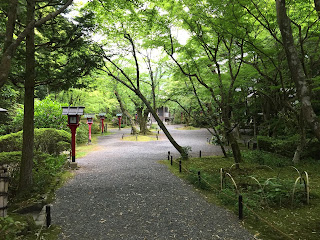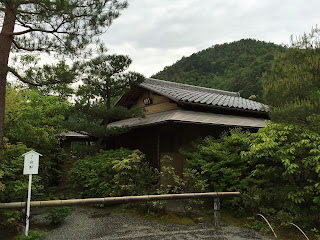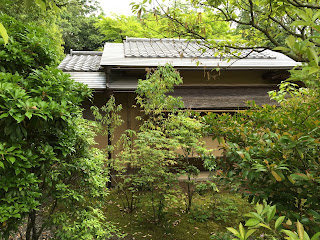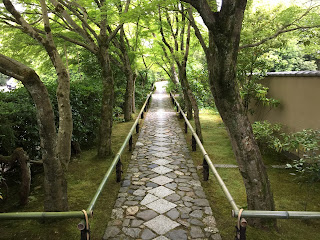2015年の5月に、京都の狩野派展、PARASOPHIA: 京都国際現代芸術祭、KYOTOGRAPHIE 京都国際写真祭 2015、光悦寺などを訪れたときの記録。 In May 2015, I visited to Kano school of Kyoto exhibition, PARASOPHIA: Kyoto International Contemporary Arts Festival, KYOTOGRAPHIE Kyoto International Photography Festival 2015 and Koetsuji so on.
2016年4月3日日曜日
琳派 - 吉野太夫と琳派の誕生 Riipa - Yoshiko Dayuh & the birth of Rinpa
常照寺には、吉野太夫という江戸時代の芸者が眠る墓がある。
吉野太夫は、元は武士だった家に生まれたが、何の縁があってか、遊女となった。
遠く、明国まで伝わったというほどの絶世の美女でありながら、琴や琵琶などの楽器も弾きこなし、書道、花道、香道もマスターし、和歌もたしなむ、スーパー女史だった。
本阿弥光悦の甥の子であった、こちらも商人でありながら一流の文化人でもあった灰屋紹益に身請けされたが、わずか38歳の若さで病死してしまった。
生前から、この寺の日乾上人に帰依していたことから、この寺に葬られることになった。
この寺の印象的な入り口の赤門は、吉野太夫が寄進したものだ。
さて、尾形光琳だが、光琳は絵の他にも、工芸の分野でも名作を残している。
八橋蒔絵螺鈿硯箱は、自らが描いた燕子花が箱にまわりに螺鈿で描かれているが、明らかに、本阿弥光悦の舟橋蒔絵硯箱に影響を受けている。
光悦は、絵を俵屋宗達から、工芸を本阿弥光悦から学び、その二つの要素を結びつけて、琳派というグループのスタイルを確立した。
光琳の絵のテーマは多彩だ。源氏物語や伊勢物語の場面を描いたり、大黒天、布袋様、虎など、中国や日本の文化的なシンボルを描いているものもある。
こちらも宗達譲りの、団扇の形の中に描いた扇面画や、細い線で描かれた、草花の絵など。
光琳は、絵のビジネスを広げようとして、1704年に江戸に行っている。
幾つかの仕事はしたようだが、あまり成功はしなかったのか、1709年には、京都に戻っている。
しかし、この5年かの江戸での暮らしは、その後の琳派の流れに、大きな影響を与えることになる。
光琳は、1716年にこの世を去った。
大阪城の役が終わってからちょうど100年。すでに、徳川家による治世はゆるぎなきものとなり、時代は、安定の時代に入っていた。
尾形光琳が、先人たちの影響の元に作り上げた、装飾性の高い芸術運動は、その後の芸術家たちに、大きな影響を与えていく。
The Joshoji, there is a tomb of a Geisha Edo called Yoshino Dayuh.
Yoshino Dayuh, the original, but was born in the house was a samurai, or if there is no edge, became a prostitute.
Far away, yet incredibly beautiful woman of about say that was transmitted to Ming, also doing play musical instruments such as the harp and lute, calligraphy, flower arrangement, also incense burning and master, Waka also Tashinamu, was super Ms.
Was a nephew of a child of Honami Koetsu, here but was also redeem in Haiya Shoeki was also a first-class cultural figures yet merchant, had died of an illness in just a 38-year-old youth.
During his lifetime, because it was devotion to the mud-holy priest of this temple, it was to be buried in this temple.
Impressive entrance of red gate of this temple, something that Yoshino Dayuh was donated.
Well, but Korin Ogata, but Korin is in addition to the picture, leaving a masterpiece in crafts fields.
Yatsuhashi Makie Raden writing box, although himself drew Iris has been drawn in Raden around the box, clearly, affected by the pontoon bridge lacquer writing box of Honami Koetsu.
Koetsu is a picture from Sotatsu Tawaraya, learned the craft from Honami Koetsu, to tie the two elements, it was established the style of the group called Rimpa.
Picture of the theme of Korin's colorful. Or depicting the Tale of Genji and the Tales of Ise of the scene, Daikokuten, sack-like, such as the tiger, even those depicting China and Japanese cultural symbols there.
Here also of Sotatsu inheritance, fan face painting and painted in the form of a fan, was drawn with a thin line, such as the painting of flowers.
Korin, in an attempt to broaden the picture of the business, are going to Edo in 1704 years.
But it seems to have some of the work, what did not so much success, in 1709, has returned to Kyoto.
However, life in Edo or this five years, the flow of the subsequent Rimpa, will be a major impact.
Korin, who died in 1716.
Exactly 100 years after the end of the role of Osaka Castle. Already, reign by the Tokugawa family becomes a thing Yuruginaki, age, was in the stability of the era.
Korin Ogata, was created on the basis of the impact of our predecessors, high art movement of the decorative is, the subsequent artists, will have a significant impact.
(Translated by Google Translate)
琳派 - 京都の呉服屋の次男坊から法橋へ Rimpa - Kimono shop to to Masters of paintings
常照寺の奥まった場所には、鬱蒼とした森に向かって、門が立っている。
この門をくぐり、森を奥まで進むと、やがて開けた場所に出て、大きな池が現れる。
以下のほとりには、白馬観音の銅像がある。白馬にまたがった観音像とは、珍しい。
尾形光琳を代表する作品といえば、紅梅白梅図屏風と、燕子花図屏風だろうか。
特に、後者の屏風絵は、金箔の地の上に、緑と青の燕子がまるで装飾画のように描かれていて、琳派の特徴をよく表す作品になっている。
紅梅白梅図屏風は、俵屋宗達の風神雷神図に影響を受けて描かれたという。風神と雷神を紅梅白梅に見立て、宗達の絵では空白であった画面の中央に、黒い川を描いている。
その宗達の風神雷神図を、光琳はトレースした上で、模写をしている。宗達へのオマージュか、あるいは、その画風を盗み出そうとしたのか。
尾形光琳は、京都の雁金屋という呉服屋の次男に生まれた。
呉服屋の服の模様の下絵などを幼い頃から目にし、それが後の芸術家、尾形光琳を生み出す源になったのかもしれない。
最初は、趣味で始めた絵の仕事は、やがて本業となり、宗達同様に、法橋という絵師の称号まで得るようになった。
The secluded location of Joshoji, toward the forest was dense, the gate is standing.
This gate wicket, and proceed through the forest to the back, out the location that opened soon, a large pond appears.
The banks of the following, there is a bronze statue of Hakuba Kannon. And across the Kannon image in Hakuba, unusual.
Speaking of work to represent the Korin Ogata, and red plum white plum folding screen, you wonder Iris figure screen.
In particular, the latter of folding screen picture is, on top of the land of gold leaf, and swallow of green and blue have been drawn like a decorative painting, has been in the works that represents well the features of the Rimpa.
Pink and white plum folding screen is, that it was drawn under the influence in Fujin Raijin diagram of Sotatsu Tawaraya. Likened the Fujin and Raijin in red plum white plum, in the picture of Sotatsu in the center of the screen was blank, it depicts a black river.
The Fujin Raijin view of the Sotatsu, Korin did on trace, we have a replication. Or a tribute to Sotatsu, or, or tried to steal their style of painting.
Korin Ogata, was born to the second son of the kimono shop that Kariganeya of Kyoto.
The eye from an early age and rough sketch of the pattern of the draper of clothes, it is after the artist, might have become a source that produces Korin Ogata.
Initially, the work of painting began as a hobby is, eventually become the core business, Sotatsu as well, began to get to the title of painter called Hohkyo.
(Translated by Google Translate)
琳派 - 常照寺 あるいは尾形乾山の登場 Rinpa - Jyosyoji & Appearance of Korin Ogata
京都、鷹峰の光悦寺のすぐ近くにある、常照寺。
本阿弥光悦が徳川家康から拝領した、いわゆる光悦村の中にあり、光悦が久遠寺から日乾という日蓮宗の僧を招いたのが、この寺の始まりだという。
緑が実に美しい。
再び、琳派に思いを戻すと、光悦、宗達の後に、尾形光琳に登場してもらわねばならない。
そもそも、琳派という名称が、この尾形光琳の名前からきている。
琳派は光琳から始まったと考えれば、その前の時代の本阿弥光悦や俵屋宗達は、琳派というよりは、前琳派ということになる。
光悦は1560年頃、宗達は1570年頃の生まれで、尾形光琳は1658年生まれなので、およそ100年の隔たりがある。
しかし、尾形光琳は、明らかに、およそ100年前に生まれた光悦や宗達の作品に大きな影響を受けて、自らも同じような作品を、あるいはそれ以上のものを作ろうと考えた。
琳派の始まりといえる尾形光琳にあって、光琳の目指したものは、それは創設というよりも、継承であった。
琳派とは、継承の中の創造のことなのだ。
Kyoto, in the immediate vicinity of the Koetsuji of falconer, there is a source light hermitage of Soto.
Originally, but it was built as a retirement destination of the high priest of the Rinzai sect Daitokuji, There is only say that Zen, in the approach to Terauchi, the Koetsuji different atmosphere, you can feel those dignified.
Again, and return the thoughts in Rimpa, Koetsu, after Sotatsu, must have my appeared to Korin Ogata.
To begin with, the name Rimpa is, it comes from the name of this Korin Ogata.
Given the Rimpa began from Korin, this Honami Koetsu and Sotatsu Tawaraya of the previous era, rather than Rimpa is made to the fact that before Rimpa.
Koetsu is 1560 BC, in the birth of Sotatsu 1570 circa, Korin Ogata is because the 1658 was born, there is a gap of about 100 years.
However, Korin Ogata, obviously, heavily influenced by the work of Koetsu was born in the year about 100 before and Sotatsu, considered trying to make the work also similar themselves, or more than that,.
In the Ogata said that the beginning of Rimpa Korin, what with the aim of Korin, it is rather than a founder, was inherited.
The Rimpa, it thing of creation in the inheritance.
(Translated by Google Translate)
2016年3月12日土曜日
琳派 - 風神雷神図とその継承 Rinpa - Wind God and Thunder God
光悦寺近くの光悦茶屋という趣のある食事処で、辛味大根ののったそばを食した。
俵屋宗達の描いた絵の中で、風神雷神図はとりわけ有名で、宗達のみならず、琳派を代表する作品に位置付けられている。
宗達の風神雷神図は、建仁寺が持っているが、それを宗達が死んで、およそ20年ほどしてから生まれた尾形光琳が目にし、その時に、本当の意味での琳派が誕生した。
そして、尾形光琳も、風神雷神図を描いた。
二つの風神雷神図は、構図はほぼ同じで、違いもよくよく見ないと、一見ではわからないほど。
時代が新しいせいか、光琳の方が、色鮮やかに見える。さらに、神々がのっている雲が、光琳の方が黒々く描かれている。
風神雷神図の継承は、光琳では終わらなかった。
光琳の死から、さらにおよそ40年後に江戸の大名の家に生まれた酒井抱一が、風神雷神図を描いた。
こちらも構図はほぼ同じだが、風神と雷神の配置などに工夫を凝らし、印象的には宗達に先祖返りしているように見える。
宗達の描いた風神雷神図は、光琳、そして抱一に引き継がれ、それは琳派の継承の系譜そのものとなった。
In quaint diet treatment that Chaya Koetsuji, ate the buckwheat topped the pungent radish.
Among the paintings of Sotatsu Tawaraya, Fujin Raijin diagrams are especially well-known, not only Sotatsu, are positioned to work to represent the Rimpa.
Fujin Raijin view of Sotatsu is, Kenninji but have, dying it Sotatsu, and about approximately 20 years later, Korin Ogata eyes that were born from, at that time, is Rimpa in the real sense of the term was born.
And, also Korin Ogata, depicting the Fujin Raijin view.
Two of Fujin Raijin figure, composition is about the same, and the difference is also not well well look, the more I do not know the look.
Perhaps because age is a new, more of Korin is, look colorful. In addition, the cloud gods are riding is, towards the Korin draw black.
Fujin Raijin view of inheritance, did not end by Korin.
From the death of Korin, Hoitsu Sakai who was born to further the Edo of feudal lords after about 40 years, it drew the Fujin Raijin view.
Here also composition is almost the same, but the ingenuity to such placement of Fujin and Raijin, appears to be in impressive are a throwback to Sotatsu.
Fujin Raijin view depicting the Sotatsu is, Korin, and carried over to the Hoitsu, it became the inheritance of genealogy itself of Rinpa.
(Translated by Google Translate)
琳派 - 琳派の祖としての俵屋宗達 Rinpa - Tawaraya Sotatsu as a root of Rinpa
光悦寺のほど近くに、光悦茶屋という食事処を見つけた。
昔は、この敷地も光悦寺の一部だったのだろう。店の奥に広がっている庭の雰囲気は、先ほど訪れた光悦寺そのものだった。
琳派の誕生は、一般には本阿弥光悦がこの地で芸術村ともいうべきものを作り、そこで様々な工芸品を作り始めたことによる、と言われている。
しかし、琳派を代表するのは、金箔をふんだんに使った独特な様式的な絵画であり、その意味では、そうした絵を描き始めた俵屋宗達をもって祖とするのが、適当ではないだろうか。
ぼかしの技法を使って描かれた、蓮池水禽図、牛図などの水墨画も、その後の尾形光琳などに引き継がれていった。
宗達の作品の中では、とりわけ、舞楽図屏風が好きだ。
この絵を見るために、わざわざ京都の醍醐寺を訪れたことがあるが、金箔の上で繰り広げられる踊りの情景は、いくら見ていても、見飽きることのない、独特の魅力を持っている。
二曲一双の屏風絵の4つのパートに、それぞれ別の衣装を着た踊り手たちが配置されている。
その配置のバランスの妙が、この絵の最大の魅力であり、また、デザインとしての絵画、という琳派の特徴をよく表している。
Enough to close Koetsuji, found a cafe that Koetsu Chaya.
In the past, I wonder this site was also part of the Koetsuji. Garden of the atmosphere that has spread to the back of the shop, was Koetsuji itself visited earlier.
The birth of Rimpa is generally Honami Koetsu is to create something should be called art village in this area, there are a variety of crafts due to the fact that the started making, is said to be.
However, the representative of the Rimpa is a unique style paintings using plenty of gold leaf, in that sense, to the father with a Sotatsu Tawaraya began to draw such a picture, or would not be appropriate.
It was drawn using a blur of technique, Hasuike waterfowl view, also ink painting, such as cattle view, were being taken over by such subsequent Korin Ogata.
Among the works of Sotatsu it is, among other things, likes bugaku figure screen.
In order to see this picture, but there is that I have purposely visited the Daigo-ji Temple in Kyoto, scene of dance that unfolds on the gold leaf, even watching much, never get tired, have a unique charm.
In four parts of the folding screen picture of the two songs Isso, dancers wearing a different costume each is located.
Strange balance of the arrangement is the biggest attraction of this painting, also, represents well the features of the Rimpa painting, that of as a design.
(Translated by Google Translate)
琳派 - 奇跡の鶴下絵三十六歌仙和歌絵巻 Rinpa - The Crane Scroll as a miracle
俵屋宗達と本阿弥光悦は、ほぼ同時代の京都で暮らしていた。
宗達が下絵を描いて、その上に光悦が字を書く、という共作の作品が、数多く残されている。
その中で、最も美しいのは、間違いなく、鶴下絵三十六歌仙和歌絵巻だろう。
2015年に京都で行われた琳派展では、この横13.5メートルの絵巻が、全編が一度に展示されて、大きな話題になった。
左から順にこの絵巻の下絵を見ていくと、岸辺に佇んでいる鶴達が、やがて大空に羽ばたき、上に下に飛びながら、最後はまた岸辺に降り立つ様子が描かれていて、まるで動く映像を見ているかのようだ。
その下絵の上に、本阿弥光悦が三十六歌仙の和歌を、光悦独特の筆つかいで書いている。
しかし、この絵巻では、明らかに宗達の下絵の方が光悦の書を圧倒しており、光悦はその勢いに押されてしまったのだろうか、途中で書き忘れた和歌を小さな文字で書き足している。
二人は、他にも同様に共作で多くの絵巻を作成したが、残念ながら、その多くは、断片に切り刻まれてしまった。
この鶴下絵三十六歌仙和歌絵巻は、奇跡のような二人のアーティストの競演の凄さを、後世の人々に伝え続けている。
Sotatsu Tawaraya and Koetsu had lived in Kyoto almost of the same age.
Sotatsu is draw a rough sketch, that Koetsu on to write a letter, work of the co-operation that have been left behind numerous.
Among them, the most beautiful, no doubt, would be The Crane Scroll.
In the Rimpa exhibition was held in Kyoto in 2015, picture scroll of the lateral 13.5 m is, the whole volume is on display at a time, it became a big topic.
When we look at in turn rough sketch of this picture scroll from left, crane are standing on the banks is, soon flapping in the sky, while flying down to the top, the last also have been drawn how the landed on the banks, like moving the video it as if looking at.
On top of the draft, the poetry of Honami Koetsu is thirty Rokkasen, wrote in Koetsu distinctive brush use.
However, in this picture scroll, has been clearly overwhelm the Koetsu book towards the sketch of Sotatsu, Koetsu wonder had been pushed to its momentum, by adding to write a write forgotten waka in the middle of a small character there.
Two people, was creating a lot of picture scroll in the same co-operation to other, unfortunately, many of which had been chopped into pieces.
This crane sketch thirty Rokkasen Waka picture scroll is, the dreadfulness of the contest of the two artists, such as a miracle, and continues to tell future generations of people.
(Translated by Google Translate)
琳派 - 俵屋宗達という謎 Rinpa - Tawaraya Sotatsu, a mystery
京都 、鷹匠の光悦寺にいる。緑一色の寺内を歩いていると、時々、趣のある茶室が現れてくる。
光悦と同じ時代を生きた絵師に、俵屋宗達がいる。光悦は、その生まれた日と死んだ日がほぼ分かっているが、宗達は不明だ。
後世にこれほど大きな影響を与えた人物が、謎のままであることは、珍しい。
おそらく、1570年頃に生まれ、1640年頃に亡くなったと考えられている。
天皇や大名が、宗達に絵を注文した、という記録が微かに残されているだけで、それ以外は、全く記録に名前を残していない。
しかし、幸いに、宗達の作品は残されている。
Kyoto, are in Koetsuji of falconer. When walking down the Terauchi of green color, sometimes, a quaint tearoom is emerge.
The same age living painter and Koetsu, there are Sotatsu Tawaraya. Koetsu is, but the day and dead the birth day is almost known, Sotatsu is unclear.
The person who gave such a great big impact on future generations is, it is unusual is remains a mystery.
Perhaps, born in 1570 around, it is thought to have died in 1640 circa.
Emperor and feudal lords, ordered the painting to Sotatsu, only are left faintly record that, otherwise, do not leave a name at all in the record.
However, it fortunately, work of Sotatsu is left.
(Translated by Google Translate)
2016年2月11日木曜日
琳派 - 光悦の死 ある時代の終焉 Rinpa - Koetsu's death and the end of a age
本阿弥光悦は、家康からもらいうけたこの鷹峰の地に、楽園ともいえる芸術村を作り、数々の名品を後世に残した。
この鷹峰の地は、豊臣秀吉が、京都の周囲に作った御土居の外側にある。つまり、当時の人々の意識では、京都の外にある地域ということになる。
今も、世界的な観光都市である京都の喧騒とは、無縁の世界が、幸いにもここにはある。
光悦の墓は、この光悦寺の一角にある。
同じ光悦寺の中の少し離れた場所には、光悦の父や母、子や孫などの本阿弥家一族の墓もあった。
光悦が生まれたのは、永禄元年、1558年で、まだ戦国時代の真っ只中だった。
大航海時代の影響は日本にも及び、西日本を中心に、南蛮文化が流行する。
光悦のような、自由な芸術が生まれた背景には、そうした激動する時代の雰囲気があった。
光悦が亡くなったのは、寛永14年、1637年。光悦にこの鷹峰の地を与えた家康はすでに亡く、第3代将軍である家光の時代になっていた。
この寛永14年には、九州で島原の乱が起こっており、江戸幕府はキリシタンなどの外国の影響を徹底的に排除するために、鎖国への道を進んで行くことになる。
光悦の死は、まるで一つの時代の終焉を象徴するような出来事だった。
Honami Koetsu is, in the land of this Takagamine undergoing got from Ieyasu, make art village that can be called paradise, leaving to posterity a number of masterpieces.
The land of this Takagamine is, Hideyoshi Toyotomi, is outside of your Doi made around Kyoto. In other words, in the consciousness of the time of the people, it comes to the region that is outside of Kyoto.
Even now, the Kyoto hustle and bustle is a worldwide tourist city, unrelated to the world, there is fortunately here.
Tomb of Koetsu is on the corner of this Koetsuji.
Same in a little away in the Koetsuji, father and mother of Koetsu, was also the tomb of Honami family home, such as child and grandchildren.
Koetsu's was born, Eiroku first year, in 1558, it was still in the midst of the Warring States period.
The influence of the Age of Discovery spans also in Japan, especially in the West, barbarian culture is prevalent.
Koetsu such as, in the free art was born background, there was atmosphere of the times that such upheaval.
Koetsu's passed away, in 1637. Ieyasu gave the land of Takagamine already died, it had become a house light of the era is the third shogun.
The 1637, and going on the Shimabara Rebellion in Kyushu, the Edo shogunate in order to eliminate thoroughly the foreign influence of the Christian, it would be to go down the road to the seclusion.
Death of Koetsu was the event, such as to symbolize the demise of like one of the era.
(Translated by Google Translate)
琳派 - 書人としての光悦 Rinpa - Koetsu as a Calligrapher
光悦寺の中は、木々が押し茂っており、全体を見通すことができない。
迷路のような内部を、立て札などを頼りに、ぐるぐると、巡ることになる。
これも、光悦のデザインなのだろう。現代の空間デザインや、都市デザインに通じるところがある。
光悦は、寛政の三筆に数えられる書人でもある。
俵屋宗達の下絵の上に和歌を書いた、数々の和歌の書が、とりわけ有名だ。
光悦は、熱心な日蓮教徒でもあったが、その光悦が書いた、日蓮の立正安国論をある展覧会で目にしたことがある。
和歌などの華麗な書に比べると、いわゆる遊びの部分は、影を潜めている。
しかし、文字の大きさを変えたり、同じ字の字体をわざと変えたりと、光悦らしさは十分に現れている名品だ。
Koetsuji Among, the trees have overgrown press, it is impossible to see through the whole.
The internal maze-like, to rely on, such as Tatefuda, round and round, will be over.
This is also, probably design of Koetsu. And contemporary of space design, there is a place that leads to the city design.
Koetsu is also in writing who is counted in there best calligraphers in Kansei age.
He wrote a poem on the Sotatsu Tawaraya sketch, The Book of numerous poetry, but especially famous.
Koetsu, which was also an avid Nichiren Muslims, the Koetsu wrote, there is a thing that you see in the exhibition which is a stand Masayasu public opinion of Nichiren.
Compared to the brilliant writing, such as poetry, part of the so-called play is hushed shadow.
However, changing the size of the character, and intentionally or changing the font of the same character, but masterpieces Koetsu likeness is that enough to appear.
(Translated by Google Translate)
琳派 - デザイナーとしての本阿弥光悦 Rinpa - Koetsu as a designer
光悦寺の大虚庵は、光悦が建てた茶室だが、その茶室自体よりも、それを囲む生垣が、光悦垣つとに知られている。
竹を編んだ独特の構成は、光悦のデザインセンスの高さを後世に伝えている。
光悦は、家業である刀の修理や目利きなどを行いながら、いろいろな工芸品を作ったりもしている。
国宝に指定されている、舟橋蒔絵硯箱は、不必要に盛り上がった上蓋が印象的な、光悦を代表するデザインだ。
また、光悦は、数多くの茶碗を作っている。
光悦の作った、不二山という茶碗は、国宝にもなっている。
光悦の茶碗は、すべて轆轤を使わずに、手を作って作られたもので、同じ京都の楽茶碗に影響を受けているようだ。
飲み口が特徴で、飲む人が飲みやすいというよりは、むしろ飲みにくく、飲むことを拒絶しているような印象がある。
硯箱にしても、茶碗にしても、道具としての本来の役割ではなく、造形的な美しさや、遊びを優先してデザインしているのが、光悦のデザインの特徴と言えそうだ。
それは、光悦のみならず、琳派全体に言えることであるかもしれない。
Taikyoan of Koetsuji is, but tearoom Koetsu was built, than the tea house itself, the hedge surrounding it, known early in the fence Koetsu.
Unique configuration braided bamboo is transmitted to posterity the design sense of the height of the Koetsu.
Koetsu is, while performing such as repair and connoisseur of the sword is a family business, it is also or create a variety of crafts.
Has been designated as a national treasure, Funabashi Makie writing box, the lid was raised to unnecessary is impressive, it is design to represent the Koetsu.
In addition, Koetsu is making a number of tea cup.
Koetsu made of, teacup that Fuji has also become a national treasure.
Cup of Koetsu, all without using a potter's wheel, which has been made to make a hand, seems to be influenced by the ease bowl of the same in Kyoto.
Drinking is a feature, rather than easy to drink a person to drink, there is impression that refused to rather difficult to drink, drink.
Even in the writing box, even in the bowl, rather than the original role as a tool, and the figurative beauty, are you design in favor of the play, likely say that features of the design of Koetsu.
It is not Koetsu only, it may be that said throughout Rinpa.
(Translated by Google Translate)
琳派 - 刀の目利きとしての本阿弥光悦 Rinpa - Honami Koetsu as a connoisseur of the sword
京都、鷹峰の法悦寺の門構え、そしてそのアプローチは、実に美しい。
本阿弥光悦の美意識を、そのままこの世の形として、表現したようだ。
光悦寺を訪れる人は、心穏やかに、この小道を歩き、その中への進んでいく。
本阿弥光悦は、代々、足利将軍家に使え、刀の修理や目利きを行っていた家柄に生まれた。
足利将軍家には、能楽の世阿弥などを始め、なんとか阿弥、という同朋集という人々がいた。
阿弥という名前は、元は時衆の信者だったが、本阿弥光悦自身は、日蓮宗の熱心な教徒だった。
光悦が生きた時代は、足利時代の終わりである戦国時代から江戸時代の時代の変わり目だった。
江戸時代の文化は、まだ生まれておらず、文化の中心はまだ京都で、足利将軍家に使えていた職人や文化人たちが、当時の文化の担い手だった。
光悦や宗達、その後の尾形光琳が作り出した琳派という芸術は、やがて、江戸時代の文化を象徴する存在になっていく。
Kyoto, Mongamae of ecstasy temple of Takagamine and its approach, is really beautiful.
The aesthetics of Honami Koetsu, as it is in the form of this world, seems to have representation.
Visitors to Koetsuji is, mind gently, to walk this path, proceed into that.
Honami Koetsu is, from generation to generation, can be used to Ashikaga shogunate, was born to the family that was going to repair and connoisseur of the sword.
The Ashikaga shogunate, started such as Zeami of Noh, was somehow Honami, people buy that companions collection called.
Named Ami, but the original was a believer of Tokishu, Honami Koetsu itself, was an avid Muslims of Nichiren Buddhism.
Koetsu lived era, it was the turn of the Edo era of the era from the Warring States period is the end of the Ashikaga era.
Culture of the Edo period, not yet born, the center of the culture is still in Kyoto, artisans and cultural people who had used the Ashikaga shogunate is, was a leading figure at the time of culture.
Koetsu and Sotatsu, art is that subsequent Korin Ogata has created Rimpa, eventually, will become a presence to symbolize the culture of the Edo era.
(Translated by Google Translate)
2016年1月24日日曜日
琳派 - 鷹峯へ Rinpa - Going to Takagamine
京都で出会った部族たち。続いては、琳派を取りあげよう。
2015年は、琳派の誕生400年を記念して、特別展など様々な行事が執り行われた。
琳派は、本阿弥光悦が、徳川家康から鷹峯の地を拝領し、ここで活動を始めたことで誕生したと言われる。
琳派400年と言われる年に、この地を訪れることは、何か意味があることのように思われた。
現在も、この鷹峯という場所は、京都の市内の喧騒から逃れて、自然に囲まれた、趣のある装いを保っている。
この地を巡りながら、琳派とは、どんなものなのだろうか、ということを考えてみた。
Tribe who met in Kyoto. It is followed, I will pick up Rimpa.
2015, to commemorate the birth 400 years of Rimpa, various events such as a special exhibition was held.
Rimpa, this Honami Koetsu is, was consecrated the land of Takagamine from Tokugawa Ieyasu, is said was born here by began activities.
In the year when it is said that Rimpa 400 years, it is to visit this land, it seemed to be that there is something meaning.
Today, the location of this Takagamine, in escape from the city's hustle and bustle of Kyoto, surrounded by nature, has remained quaint attire.
While Tour of this land, the Rimpa, what a wonder, I tried to think that.
(Translated by Google Translate)
2016年1月10日日曜日
Looking back KYOTOGRAPHIE 2015 京都国際写真祭2015を振り返る
このKYOTOGRAPHIEは、これで3度目となる開催とのことだが、初めて訪れてみた、その面白さを実感できた。
一番の魅力は、京都らしい町屋や庭の風景の中で、世界の様々な写真家の作品を鑑賞できることにある。
それぞれの会場の展示の仕方も工夫されているので、会場に向かうのが楽しみになる。
東京のモダンな美術館で開催される写真展とは、一味も二味も違った趣で、京都でしか体験できない、稀有の写真展だ。
京都という町自体が、写真の被写体になることが多いが、その被写体の中に、別なコンテキストの被写体が展示されている。
ここに、京都という町の大きな秘密があるように思える。
2016年も開催されるとのことで、すでに参加する写真家たちの名前も公開され始めている。
是非とも、また訪れてみたい。
This KYOTOGRAPHIE, although thing and held that becomes This third time, tried to visit for the first time, I can feel the fun.
Most of charm, in the landscape of Kyoto seems Machiya or in the garden, is that I can admire the work of various photographers of the world.
Because it is devised each venue of the exhibition way also the towards the venue to become fun.
Differentially The photo exhibition held at the modern art museum of Tokyo, a little bit at even different flavor, can not be experienced only in Kyoto, it's rare photo exhibition.
Town itself that the Kyoto, is often to be in the photograph of the subject, in its subject, the subject of another context are exhibited.
Here, it seems like there is a big secret of the town of Kyoto.
By and also in 2016 will be held, it has already begun to be also published the name of the photographer who participate.
By all means, also I want to visit.
(Translated by Google Translate)
2016年1月9日土曜日
KYOTOGRAPHIE - ボードワン・ムアンダ Baudouin Mouanda
KYOTOGRAPHIE で、最後に訪れたのは、四条大橋からすぐのところにある、村上重ビル。
1階はカフェで、地下が会場になっていた。
この会場では、1981年コンゴ生まれのボードワン・ムアンダのユニークな作品が、スライド形式で展示されていた。
コンゴには、カラフルなスーツを着こなして街中に集う、サプールと呼ばれる人々がいる。
コンゴは、フランス領だったが、フランスの人々が持ち込んだファッションが、地元の人々に影響を与え、アフリカ人らしい、原色を使ったファッションが流行するようになった。
この展覧会が終わり、東京に戻ってきてから、本屋でこのボードワン・ムアンダのサプールの写真集をよく見かけるようになった。
確かし、黒人たちがカラフルなスーツを着ている、というイメージは、人々の心に訴えかけるものがある。
In KYOTOGRAPHIE, I visited the last, there is just a from Shijo Ohashi, Murakami heavy building.
The first floor is a cafe, underground had become the venue.
In this venue, unique piece of Baudouin Mouanda of 1981 Congo born, was exhibited in slide format.
The Congo, gather in the city to dress colorful suits, there are people called Sapeurs.
Congo, which was a French territory, fashion that brought the French people, affect the local people, seems to African people, fashion using the primary colors have come to the epidemic.
This exhibition is the end, after coming back to Tokyo, began to see well the photo collection of Sapuru of tBaudouin Mouanda in the bookstore.
Certainly, the black people are wearing colorful suits, the image that, there are things that appeal to people's hearts.
(Translated by Google Translate)
KYOTOGRAPHIE - ルイ・ジャム Louis Jammes
白川から少し北に歩いた場所にあるSferaExhibitionでは、フランス、カルカソンヌ生まれのルイ・ジャムの作品が展示された。
2階の展示会場に上がると、薄暗い雰囲気の中に、チェルノブイリで暮らす人々を撮影した作品が展示されていた。
2011年の東日本大震災に伴う、福島原発事故を経験した日本人にとって、チェルノブイリの人々は、とりわけ身近に感じられる人々になった。
しかし、意外にも、現在のチェルノブイリに暮らしていた、あるいは暮らす人々の現在の姿は、なかなか私たちには伝わってこない。
この薄暗い会場の中で、改めてそのことを感じるとともに、今ではウクライナ領となったチェルノブイリに思いを馳せた。
In SferaExhibition in the location where I have a little walk north from Shirakawa, France, the works of Louis jam of Carcassonne born were exhibited.
When I go up on the second floor of the exhibition hall, in the dim atmosphere, works that have taken people who live in Chernobyl it had been exhibited.
Due to the 2011 Great East Japan Earthquake, for the Japanese who experienced the Fukushima nuclear accident, the people of Chernobyl, has become the people that are felt especially familiar.
However, surprisingly, the current appearance of it was lived in the current Chernobyl, or class of people, it does not come easily transmitted to us.
In this dim venue, as well as once again I feel that, it was thinking of the Chernobyl became the Ukraine territory is now.
(Translated by Google Translate)
登録:
コメント (Atom)






































